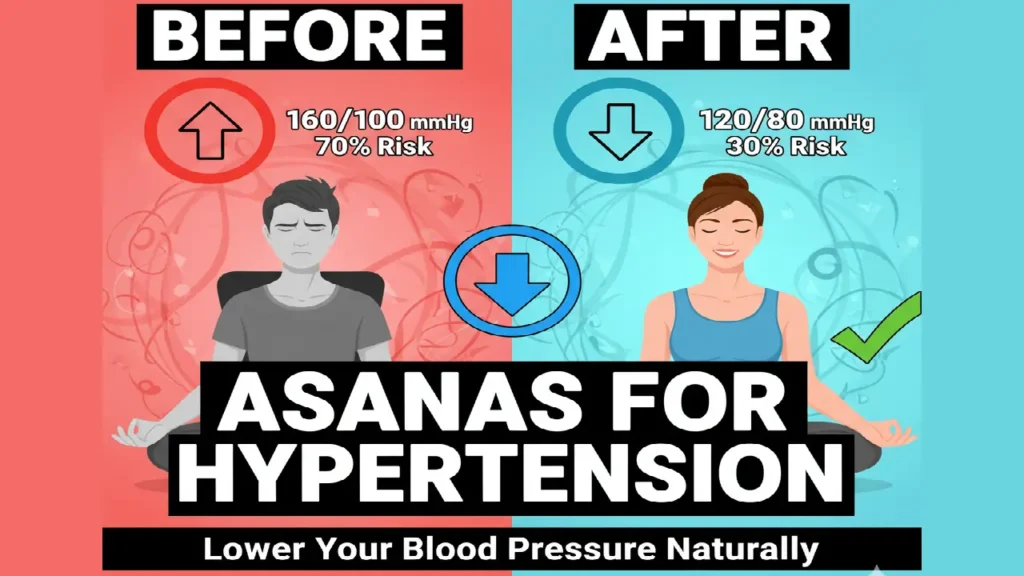Asanas For Hypertension

I had never considered that my blood pressure was an issue before when my doctor made it a point to indicate it during a check-up visit. I felt all right, and the figures would not tell the truth. Similar to millions of other people, I had hypertension, a silent disease that predisposes the heart disease and the stroke. As long as I continue taking medication, I was resolved to identify a natural approach to aid my body.
Yoga, as a powerful and ancient tool, took me to my research and personal experience. I have learned that not every yoga works with high blood pressure, but with the appropriate yoga poses for hypertension, you can make a real change. A Mayo Clinic Proceedings review in 2019 identified that consistent yoga practice could result in major blood pressure decreases, particularly when it involves breathing and meditation.
Why Yoga is effective in Blood Pressure.
Hypertension is not merely a physical disorder, it is closely interconnected with stress. When we are under all types of constant stress, our sympathetic nervous system (fight-or-flight response) is overloaded, and it keeps our heart rate and blood pressure high. Correct type of yoga is a kind of switch that relaxes this system and switches on to the parasympathetic nervous system that deals with rest-and-digest. It trains the mind and muscles to be fully relaxed and this slows the heart and helps in reducing blood pressure in the long term.
This effect has been proved scientifically. In one meta-analysis, yoga was determined to have preliminary recommendation as an effective intervention in blood pressure reduction. The other study established that a short and basic yoga program that is done at home has the potential to reduce the diastolic blood pressure and enhance quality of life. The trick lies in the regular practice that includes soft poses, breathing as well as meditation.
Yoga Pose to Embrace to lower Blood Pressure.
Exercises that help in hypertension include the best forward bends and supported postures that are calming without straining the heart. Some of the most recommended poses are summarized in the table below.
Alternate Nostral Breathing (Nadi Shodhana): It is a good breathing technique to balance the nervous system. Inhale softly using the left nostril then close it and exhale using the right. Breath in right and out in left then. This is one round .
Slow Abdominal Breathing: relaxation can be produced by simply concentrating on slow and deep breaths in the belly and not the chest. Breath approximately 6 times per minute.
Yoga Postures to evade High Blood Pressure.
Safety is paramount. Some poses may also have a temporary effect of increasing blood pressure and should not be practiced unless under the supervision of an experienced therapist.
Full Inversions: Do not do Headstand (Sirsasana) and Handstand (Adho Mukha Vrksasana) since it puts more blood into the head.
Strenuous Holds: Poses that squeeze the diaphragm or need extreme effort, such as Shoulderstand (Sarvangasana), Wheel Pose (Urdhva Dhanurasana), and Bow Pose (Dhanurasana) may cause an increase in blood pressure.
General Rule: when you feel flushed or strained or find that your breath has become heavy, get out of the pose and rest in Child Pose.
Commonly Included Questions (FAQs).
Q1: How frequently do you think I should practice yoga in order to achieve results in my blood pressure?
A: It is more about the consistency than durability. A 2019 review proposed that an hour long practice five times per week had considerable benefits. Nevertheless, a daily practice of 15-30 minutes could also work out even though it is often shorter.
Q2: Is it possible to discontinue my blood pressure medication, in case I start doing yoga?
A: No. Yoga is not an alternative medicine, it is a complementary therapy. The changes to your medication should be made only after consulting your doctor.
Q3: I’m not flexible. Is it still possible to do these asanas in case of hypertension?
A: Absolutely! Yoga hypertension is relaxation rather than being flexible. Support your body with props such as bolsters, blankets and chairs in the poses. It is aimed at being relaxed and peaceful.
Q4: Can I take a hot yoga session when I have high blood pressure?
A: This is usually not advisable. This heat, strenuous physical activity and some of the poses may be unsafe to patients with hypertension. Take moderate, relaxing or advanced classes in a cool room.
Having been on a yoga path has enlightened me that it is more of mind relaxation than body curing in dealing with hypertension. The right asanas will help you to become an active participant in your health and well-being, decrease stress, and take care of your heart in the long-run by selecting the appropriate asanas to reduce hypertension and practicing them regularly.
